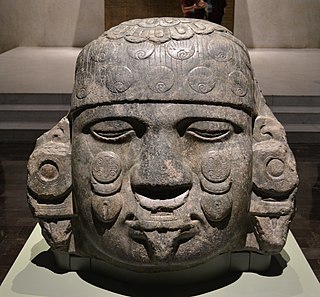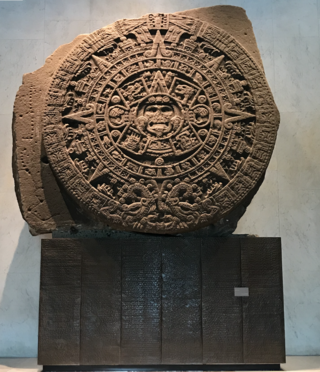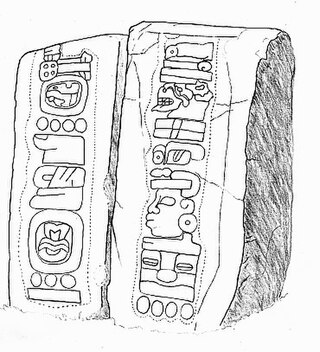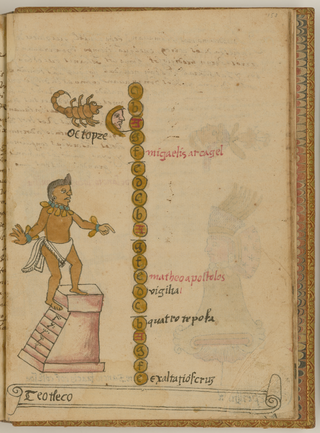
The Aztecs were a Mesoamerican culture that flourished in central Mexico in the post-classic period from 1300 to 1521. The Aztec people included different ethnic groups of central Mexico, particularly those groups who spoke the Nahuatl language and who dominated large parts of Mesoamerica from the 14th to the 16th centuries. Aztec culture was organized into city-states (altepetl), some of which joined to form alliances, political confederations, or empires. The Aztec Empire was a confederation of three city-states established in 1427: Tenochtitlan, city-state of the Mexica or Tenochca; Texcoco; and Tlacopan, previously part of the Tepanec empire, whose dominant power was Azcapotzalco. Although the term Aztecs is often narrowly restricted to the Mexica of Tenochtitlan, it is also broadly used to refer to Nahua polities or peoples of central Mexico in the prehispanic era, as well as the Spanish colonial era (1521–1821). The definitions of Aztec and Aztecs have long been the topic of scholarly discussion ever since German scientist Alexander von Humboldt established its common usage in the early 19th century.

In Aztec religion, Coyolxāuhqui is a daughter of the priestess Cōātlīcue. She was the leader of her brothers, the Centzon Huitznahua. She led her brothers in an attack against their mother, Cōātlīcue, when they learned she was pregnant, convinced she dishonored them all. The attack is thwarted by Coyolxāuhqui's other brother, Huitzilopochtli, the national deity of the Mexicas.

Huitzilopochtli is the solar and war deity of sacrifice in Aztec mythology. He was also the patron god of the Aztecs and their capital city, Tenochtitlan. He wielded Xiuhcoatl, the fire serpent, as a weapon, thus also associating Huitzilopochtli with fire.

The Aztec or Mexica calendar is the calendrical system used by the Aztecs as well as other Pre-Columbian peoples of central Mexico. It is one of the Mesoamerican calendars, sharing the basic structure of calendars from throughout ancient Mesoamerica.

The calendrical systems devised and used by the pre-Columbian cultures of Mesoamerica, primarily a 260-day year, were used in religious observances and social rituals, such as divination.
The Anales de Tlatelolco is a codex manuscript written in Nahuatl, using Latin characters, by anonymous Aztec authors. The text has no pictorial content. Although there is an assertion that the text was a copy of one written in 1528 in Tlatelolco, only seven years after the fall of the Aztec Empire, James Lockhart argues that there is no evidence for this early date of composition, based on internal evidence of the text. However, he supports the contention that this is an authentic conquest account, arguing that it was composed about 20 years after the conquest in the 1540s, and contemporaneous with the Cuernavaca censuses. Unlike the Florentine Codex and its account of the conquest of the Aztec Empire, the Annals of Tlatelolco remained in Nahua hands, providing authentic insight into the thoughts and outlook of the newly conquered Nahuas.
The xiuhpōhualli is a 365-day calendar used by the Aztecs and other pre-Columbian Nahua peoples in central Mexico. It is composed of eighteen 20-day "months," called veintenas or mētztli with a separate 5-day period at the end of the year called the nemontemi. Whatever name that was used for these periods in pre-Columbian times is unknown. Through Spanish usage, the 20-day period of the Aztec calendar has become commonly known as a veintena. The Aztec word for moon is mētztli, and this word is today to describe these 20-day periods, although as the sixteenth-century missionary and early ethnographer, Diego Durán explained:
In ancient times the year was composed of eighteen months, and thus it was observed by these Indian people. Since their months were made of no more than twenty days, these were all the days contained in a month, because they were not guided by the moon but by the days; therefore, the year had eighteen months. The days of the year were counted twenty by twenty.

The Codex Tovar is a historical Mesoamerican manuscript from the late 16th century written by the Jesuit Juan de Tovar and illustrated by Aztec painters, entitled Historia de la benida de los Yndios a poblar a Mexico de las partes remotas de Occidente. The codex is close in content, but not identical, to the Ramírez Codex. It is currently kept at the John Carter Brown Library, in Providence, Rhode Island, United States.

The Coyolxāuhqui Stone is a carved, circular Aztec stone, depicting the mythical being Coyolxāuhqui ("Bells-Her-Cheeks"), in a state of dismemberment and decapitation by her brother, the patron deity of the Aztecs, Huitzilopochtli. It was rediscovered in 1978 at the site of the Templo Mayor of Tenochtitlan, now in Mexico City. This relief is one of the best known Aztec monuments and one of the few great Aztec monuments that have been found fully in situ.
Oxomoco also known as Oxomo is an Aztec deity, the goddess of the night, the astrology and the calendar. Oxomoco and Cipactonal were said to be the first human couple, and the Aztec comparison to Adam and Eve in regard to human creation and evolution. They bore a son named Piltzintecuhtli, who married a maiden, daughter of Xōchiquetzal. As an older woman she was also known as Itzpapalotl.
The Mexica New Year is the celebration of the new year according to the Aztec calendar. The date on which the holiday falls in the Gregorian calendar depends on the version of the calendar used, but it is generally considered to occur at sunrise on 12 March. The holiday is observed in some Nahua communities in Mexico. To celebrate, ocote (pitch-pine) candles are lit on the eve of the new year, along with fireworks, drumming, and singing. Some of the most important events occur in Huauchinango, Naupan, Mexico City, Zongolica, and Xicotepec.
Tozoztontli is the name of the third month of the Aztec calendar. It means Little Perforation. It is also a festival in the Aztec religion, the deities are Centeotl, Tlaloque, Chicomecoatl and Coatlicue. It marks the end of the dry season. It is the season of bird sacrifices and is called The Little Vigil.
Quecholli is the name of the fourteenth month of the Aztec calendar. It is also a festival in the Aztec religion and the Principal deity is Mixcoatl. It is called the Precious Feather and hunting is done during this season.
Tlaxochimaco is the name of the ninth Month of the Aztec calendar. It is also a festival in the Aztec religion, dedicated to the Aztec God of War Huitzilopochtli. It is called the Bestowal or Birth of Flowers.
Huey Tozoztli also known as Huey Tocoztli is the name of the fourth month of the Aztec calendar. It is also a festival in the Aztec religion dedicated to Tlaloc and other deities. It is called the great or long vigil.

Tecuilhuitontli is the name of the Seventh month of the Aztec calendar. It is also a festival in the Aztec religion. The principal deity is Xochipilli and feasts are also given to Goddess Huixtocihuatl and it is known as the Small Festival of the Lords.

Teotleco is the name of the twelfth month of the Aztec calendar. It is also a festival in the Aztec religion and is known as the festival of All gods where all gods are worshiped.
Etzalcualiztli is the name of the sixth month of the Aztec calendar. It is also a festival in the Aztec religion dedicated to Tlaloc and Chalchihuitlicue.
Huey Tecuilhuitl also called Uey Tecuilhuitl is the name of the eighth month of the Aztec calendar. It is also a festival in the Aztec religion dedicated to Xilonen and Cihuacoatl. It is called the Great festival of the Lords.

Izcalli is the name of the eighteenth and last month of the Aztec calendar. It is also a festival in the Aztec religion, for which the principal deity is Xiuhtecuhtli the fire God. Old people are honored this month and it is known as Rebirth Month.










